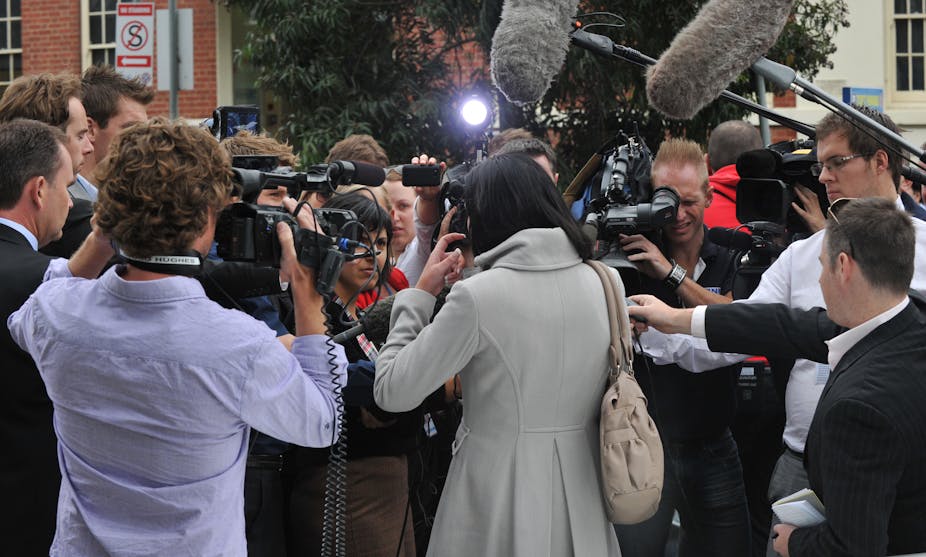We usually don’t like tricky women. Even worse, tricky girls like the alternately cunning and naïve teenager who recently got the better of several AFL players, a player manager, and, arguably, the football league itself.
Girls and women have not traditionally had access to the same kinds of power and privilege as men. Instead they have often sought to fulfil their desires, seek justice and even gain retribution through wily manipulation of the narrow sliver of action to which they have had rightful access. The male who triumphs over his foes is a hero. The female who does so against the weight of patriarchal power is often regarded as a spiteful troublemaker. She is anything but admired.
The recent AFL saga has exposed seething public vitriol about the attempts at revenge exacted by a lone teenage girl. She does not appear to have a job, finances or even parental support. In comparison, powerful adult male sporting elites earn more than most professionals, dominate all forms of media, and are celebrated by a massive fan-base for their physical prowess.
Many people nevertheless felt that Goliath was hard done by. Few experienced a stir of empathy for the brave, if misguided and sometimes deceitful, attempts by this female David to strike a blow in response to her perceived sexual and emotional exploitation.
The tricky woman has the audacity to disrupt societal conventions that silence, exploit or discriminate against her. History and mythology hide stories about such women underneath a thick layer of male heroism and rebellion. Yet the tales of these women are no less compelling than those of men who were on gender’s “winning team”.
Women have assumed male personas as one strategy to evade gender restrictions. Female authors from George Eliot (Mary Anne Evans) to the Brontë sisters adopted male pseudonyms to avoid pre-judgement of their writing. The work of a female author might be assumed to be inferior because of its origin in a female mind. In the mid-nineteenth century, French writer George Sand (Amantine Dupin) scandalously took to the comfort and public freedom of wearing men’s clothing to match her male nom de plume.
Less well known are women who actually sought to pass as male. In 1807, Scotswoman Isobel Gunn adopted male clothing to masquerade as a labourer. Through her deception, Gunn became the first European woman to journey to Western Canada. Her ability to pass as a man was so accomplished that she remained undetected by the men she toiled alongside for the Hudson’s Bay Company. Even travelling close to 3,000 miles on foot with them to present day North Dakota did not give up her secret. That is until, to their great surprise, she gave birth to a son.
Isobel’s success in posing as a man defied contemporary standards that dictated women’s inferior strength and weak constitution and which relegated women’s work to lower rates of pay than men’s. Yet Isobel might also be seen as a tricky woman because of the legend that she conducted this elaborate ruse to trail a former lover who had discarded her.
If disguise in name or dress was not a palatable option, outright contravention of feminine norms, or “badness”, might prevail. Historian Sarah Carter has written about an outcast Calgary woman, Caroline “Mother” Fulham, who eschewed proper femininity and embraced disorder at the end of the nineteenth century. She farmed pigs, collected garbage from local businesses to feed them and drank to the point of staggering, and vocal, intoxication. Her lifestyle saw her declared “a moral leper” by a local senator in one of many apparent courthouse appearances.
As Carter observes, women such as Fulham mapped out what was acceptable femininity and which qualities had to be repressed. The bad girl or woman had to curtail her behaviour or face exclusion from society. Fiction also had the option of an untimely death to neatly dispose of unrepentant transgressors of femininity.
In the vastly popular genre of British girls’ school stories in the early twentieth century, rebel girl protagonists are inevitably convinced of the undesirability of their freewheeling, independent ways. They learn the superiority of obedient compliance, and so, it was assumed, would masses of girl readers.
Socialising orderly girls was, and still remains, important to shape the kind of women a culture desires. Girlhood can be imagined as a period of danger, in which inert potential for waywardness and rebellion might be activated.
Mythology offers up an example of the potential destruction that can result from a girl’s newly discovered and unharnessed abilities. Among the goddess Artemis’s first deeds was an arrow shooting-spree in which she targeted an elm, an oak, a wild animal, and, most importantly, a city of unjust men. These men, who committed wicked acts against each other and upon strangers, were pierced with the flight of one of Artemis’s arrows, which did not come to rest until all were dead.
Our latest bad girl is not a suffragette on a soapbox or a world traveller when women were monitored by chaperones. Neither does she resemble the mythical Scheherazade, who risked her own life to successfully save the lives of other women with her story telling. Depending on the true circumstances of her involvement with men of the AFL, perhaps she might share traits with the young Artemis, newly equipped with a quiver of arrows.
Though many commentators have chosen to describe the girl as an adult to emphasise her culpability, her impulsive actions tellingly show a still-maturing girl unable to cope with the magnitude of the media spectacle. Her arrows of retaliation may be wildly directed and dependent on untruths, but their targets may just be rightly chosen, like Artemis’ unjust men. The anger directed toward this girl shows the continued threat of the tricky woman to men keen to maintain their power and privilege.

